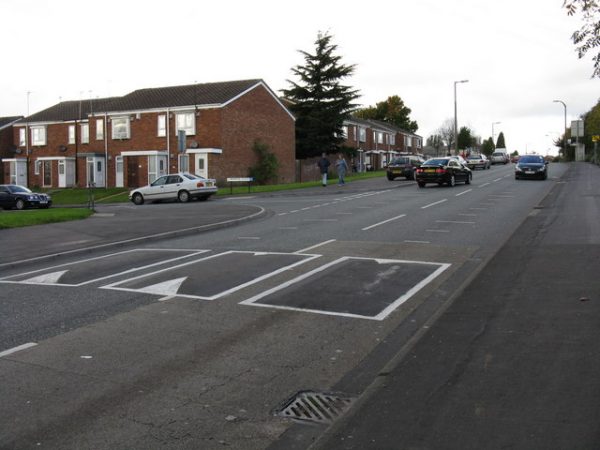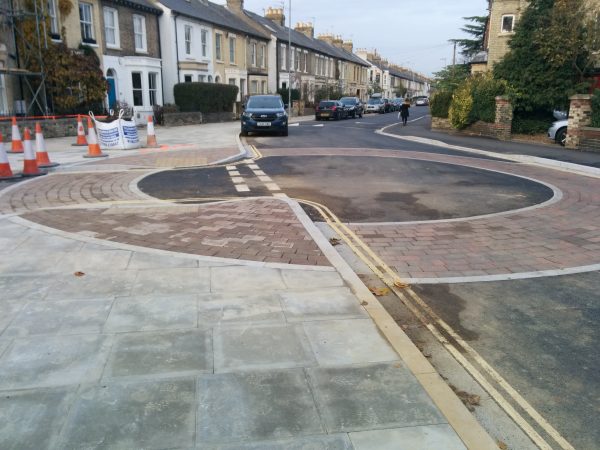Launched last year and continuing into next year, a pilot program in London is testing the efficacy of a peculiar new traffic calming measure — one that uses tricks of perspective to slow drivers down.
The flat design presents an illusory impediment to oncoming vehicles, causing drivers to anticipate a jolt that never actually materializes. Like the strange ghost roundabout that appeared around the same time in the UK, it is part of a strategy aimed at controlling speeds without the use of jarring interventions like bumps, humps and lumps.
All those “umps” may look like synonyms at a glance, but bumps, humps and lumps are actually all distinct types of traffic calming measures (in addition to undulations and tables). While definitions, details and dimensions vary from place to place, here is an overview:
- Speed bumps: One long stretch of raised asphalt up to five inches tall and a few feet deep, meant to slow traffic to less than ~10 mph
- Speed humps: One long stretch of raised asphalt up to three inches tall and often deeper than bumps, meant to slow traffic to ~25 mph
- Speed lumps: Divided humps with the spacing sized to allow emergency vehicles with a wider wheelbase to pass unimpeded
- Speed tables: Low like humps, but up to ten feet deep and flat on top, further easing movement while keeping traffic to ~30 mph or less. These sometimes also serve as raised crosswalks.
- Traffic undulations: Variably defined, but in some cases used to denote sequential sets of speed humps along a longer street. In other cases, the term is used to describe humps or tables.
In most cities, what people call “bumps” are really humps or lumps — these are often just lumped together in everyday language. For a neat infographic and short radio story on these types, check out Sacramento Traffic ‘Calming’ Takes Many Forms on Capital Public Radio. Keep in mind, though, that the definitions they use are city-specific.

Speed bumps, while useful, can increase noise in a neighborhood thanks to cars slowing down and speeding up. They can also cause discomfort for drivers and passengers and impede emergency vehicles. Speed humps are a bit smoother, addressing noise and discomfort. Speed lumps help emergency vehicles by creating space between each hump specifically designed to let them pass through the gaps.

While the test program in London could lead to a reduced use of other more tangible traffic-calming measures, it can’t really do away with them — without some real bumps, lumps and humps to jostle speeders, the optical illusion wouldn’t have the desired effect. [Special thanks to fans Raphy Goldberg & Marcus Alvarez for suggesting this story]



Comments (5)
Share
So training drivers to ignore children in the road, eh? Genius.
Sounds like something a coyote would do to try to catch a roadrunner.
I don’t understand the British obsession with distracting their drivers.
Anyone else catch this?: “Speed tables: Low like humps, but up to ten feet deep and flat on top” is it really 10 feet or did they mean inches?
Feet. In the list ‘tall’ refers to height and ‘deep’ refers to length, or: distance parallel to the road (while ‘width’ is an unlisted variable as it depends on the width of the lane and parking on the sides). Since the tables example doesn’t explicitly list the height I can see how it would be confusing in isolation.